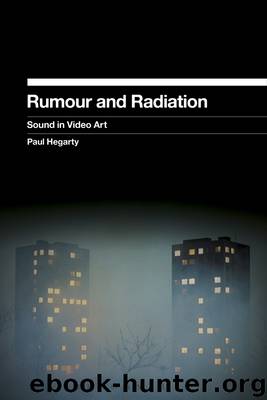Rumour and Radiation by Paul Hegarty

Author:Paul Hegarty
Language: eng
Format: epub
Publisher: Bloomsbury
FIGURE 7.1 Christian Marclay, Guitar Drag (2000). DVD projection with sound; fourteen minutes. Courtesy White Cube.
In the course of the 1960s, musicians began to push amplification further, looking for distortion and opening a range of sounds beyond the controllable tones of proper string playing.6 Marclay both refers to this expansion of the soundmaking properties of the electric guitar and undermines the heroism that the guitarist acquired in the same period. For all his creativity and skill, Jimi Hendrix was a different kind of guitar hero to almost all the others – happy to stretch way outside traditional patterns of solo-ing and into much freer terrains, and, famously, using the destruction of the guitar as a source of music. It is not so much that action (as captured at Monterey jazz festival in June 1967 when he lights the guitar and concedes the soundmaking to the object itself) but the playing of the American national anthem at the Woodstock festival that Guitar Drag conjures for me. In a set of devastating experimentation, this piece stands out for its capacity to re-form the anthem, and to unpick its intent and structure without destroying it, such that the mass of distortion, feedback and howling summons the prospect of a true utopia hinted at but currently elided by the reality of the modern United States of America.7 This then is how we come back through the sound of the piece to the narrative elements.
There is still more to the piece – it has to be staged in a room, in large-scale projection form, with guitar blaring. There was a record released, peculiarly, further materializing the aleatory tones of the dragged guitar – something from next to nothing that was close in finalized form to the sounds emanating from Marclay’s New York contemporaries Sonic Youth. The tying of the guitar to truck also takes some time at the beginning, parodying the tuning up or the practice guitarists are encouraged to perform. The dirt tracks have no such readying, yet their contours imprint on the strings, pickups and so on of the guitar, such that Guitar Drag also becomes a kind of no-wave land art, an instant, multiple rethinking of Richard Long’s walks or the interventions of Robert Smithson or James Turrell.
In another rare example of Marclay using ‘non-found’ material, Solo (2008) plays out another history of the guitar, with the guitar as sex object, conduit or even participant. A young woman (played by actress and musician Tree Carr) arrives in a studio, bumps the drumkit, and the drum sticks fall. On foot of this, she sees a guitar standing upright in its stand, plugged in and ready. Slowly, tentatively, she begins to play it, at first jumping back as it responds. Slowly she takes control, her hands moving across the neck and body. She then moves to play the guitar with her whole body, starting to take her clothes off as the piece progresses. She and the guitar rub together, and sounds spark off from its strings.
Download
This site does not store any files on its server. We only index and link to content provided by other sites. Please contact the content providers to delete copyright contents if any and email us, we'll remove relevant links or contents immediately.
Aircraft Design of WWII: A Sketchbook by Lockheed Aircraft Corporation(32187)
The Great Music City by Andrea Baker(31246)
Call Me by Your Name by André Aciman(20347)
The Secret History by Donna Tartt(18802)
The Art of Boudoir Photography: How to Create Stunning Photographs of Women by Christa Meola(18500)
Shoot Sexy by Ryan Armbrust(17633)
Plagued by Fire by Paul Hendrickson(17313)
Portrait Mastery in Black & White: Learn the Signature Style of a Legendary Photographer by Tim Kelly(16931)
Adobe Camera Raw For Digital Photographers Only by Rob Sheppard(16880)
Photographically Speaking: A Deeper Look at Creating Stronger Images (Eva Spring's Library) by David duChemin(16596)
Ready Player One by Cline Ernest(14488)
Pimp by Iceberg Slim(14308)
Bombshells: Glamour Girls of a Lifetime by Sullivan Steve(13949)
The Goal (Off-Campus #4) by Elle Kennedy(13453)
Art Nude Photography Explained: How to Photograph and Understand Great Art Nude Images by Simon Walden(12950)
Kathy Andrews Collection by Kathy Andrews(11705)
The Priory of the Orange Tree by Samantha Shannon(8848)
The remains of the day by Kazuo Ishiguro(8784)
Thirteen Reasons Why by Jay Asher(8762)
